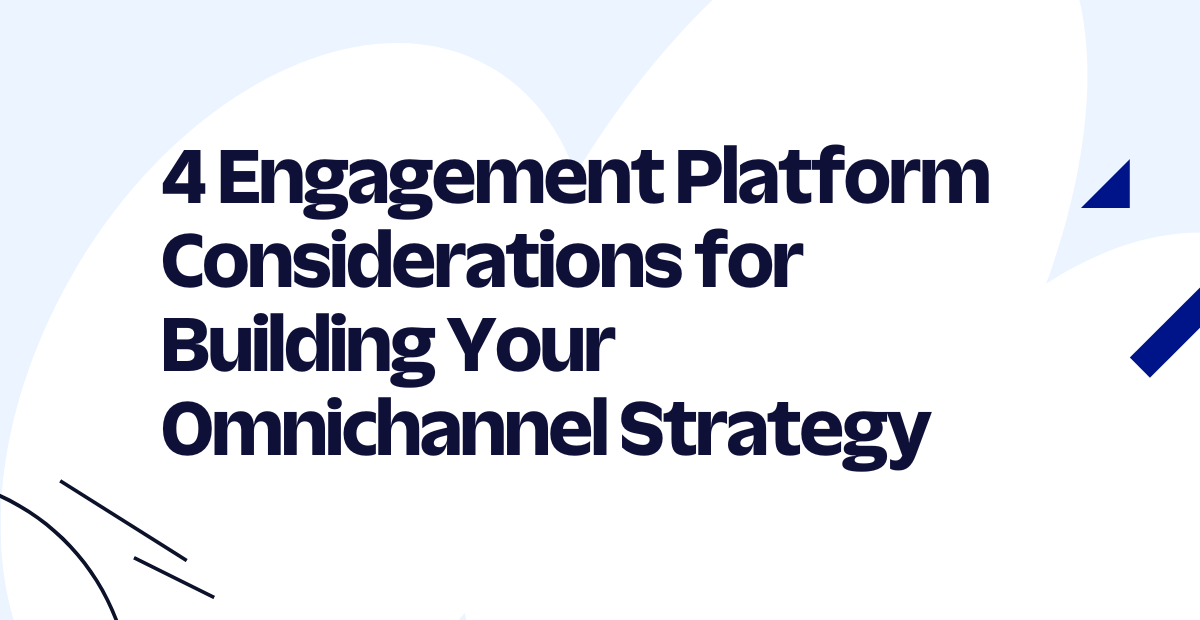4 Engagement Platform Considerations for Building Your Omnichannel Strategy
Time to read: 3 minutes

Effective customer engagement is key to differentiating brands in any market. 75 percent of consumers have rewarded businesses that communicate in the way they prefer.
So, it’s no surprise that meeting and exceeding customers’ expectations for fast, easy, omnichannel, and personalized interactions requires a trusted customer engagement platform to centralize every channel in the customer journey. That said, there are hundreds of customer engagement solutions to choose from—so what should you look for to narrow down your search?
Getting into the nitty-gritty requires we put on our developer hat and look at things through an engineering lens, but with support from your team, you’ll quickly sort the wheat from the chaff. Here are four key areas you’ll need to consider.
Developer experience: get ideas to market quickly
If your team is building the future of communications for your company, they need a CPaaS provider with all the technical resources to deploy, integrate, and iterate quickly. Make sure the customer engagement platform you choose can meet your needs in these areas:
- Documentation. Make sure it’s thorough and in the language your developers prefer. Check if there are example code snippets, quickstarts, SDKs, and helper libraries to get your team started.
- Support resources. Ask about what your team needs, like a serverless environment, command-line interface (CLI), or visual workflow builder to ensure your platform can offer it.
- Provider’s community. Make sure the vendor and documentation are supported by an engaged community for developers, sharing their experiences and best practices.
Learn more at SIGNAL 2021: The power of audio transcriptions: ING unlocks the value of conversations
Product development: differentiate through customer engagement
Each channel requires a significant amount of product focus to be resilient and flexible. It’s one thing to be able to make a channel available—it’s entirely another to be able to handle communications at scale, to make it easy for customers to integrate into current systems, and to ensure those channels talk to each other seamlessly.
- Prioritize API quality. Most importantly, you want the engine fueling your customer engagement to “just work.” You don’t want to worry about reliability issues causing communications to never reach customers. Choose a vendor whose APIs are a core focus of the business, with long-term investment in their quality.
- Evaluate software layers. As you begin to scale communications, the experience becomes more complex. Look for vendors who have built software to help solve common challenges around scale, integration, content, and compliance.
Confirm product innovation. Make sure your vendor is equipped to support your current and future customer engagement strategies. Research the channels supported and ease of adding those channels into your current process.
Sales engineering: support your specific use-case
Even with documentation and a reliable platform, you still need to build to your specific use cases and goals, meaning you need experts who can empower your developers to build.
- Talk with sales engineers. Make sure your vendor has sales engineers or product specialists who can drive technical alignment, propose the right solutions based on your specific use case, and build demos alongside your team to accelerate development.
- Confirm support. Evaluate both free and paid support, understand who you talk to if something goes wrong, find out if that team is available around-the-clock, and if there is regional support.
Learn more at SIGNAL 2021: Understanding call behavior with Voice Insights
Carrier relations: simplify telecom complexities and regulations
When you get up-and-running, you need to trust that you’ll stay up-and-running.
- Check for global connectivity. Research vendors’ connections with carriers globally, the resources they have to support those relationships, and the routing depth they’ve established.
- Analyze the infrastructure. Your vendor should identify issues before you ever feel the impact. Look into the network monitors, incident detection, and response vendors have in place.
- Prioritize operational excellence. Data privacy and security is crucial. If you have a global customer base, regulations can become even more complex. Your vendor needs to have the security, data privacy, and engineering best practices to ensure your data is safe as you scale.
Learn how to maximize the value of your customer engagement platform
As customer engagement continues to rapidly evolve, it’s essential you have a robust solution that can support your organization through its digital transformation and beyond. Innovating customer engagement is about more than out-of-the-box solutions––it’s about building something unique that keeps your customers engaged for the long term.
To learn more about the future of customer engagement and best practices for building, check out the sessions at SIGNAL 2021.
Related Posts
Related Resources
Twilio Docs
From APIs to SDKs to sample apps
API reference documentation, SDKs, helper libraries, quickstarts, and tutorials for your language and platform.
Resource Center
The latest ebooks, industry reports, and webinars
Learn from customer engagement experts to improve your own communication.
Ahoy
Twilio's developer community hub
Best practices, code samples, and inspiration to build communications and digital engagement experiences.


